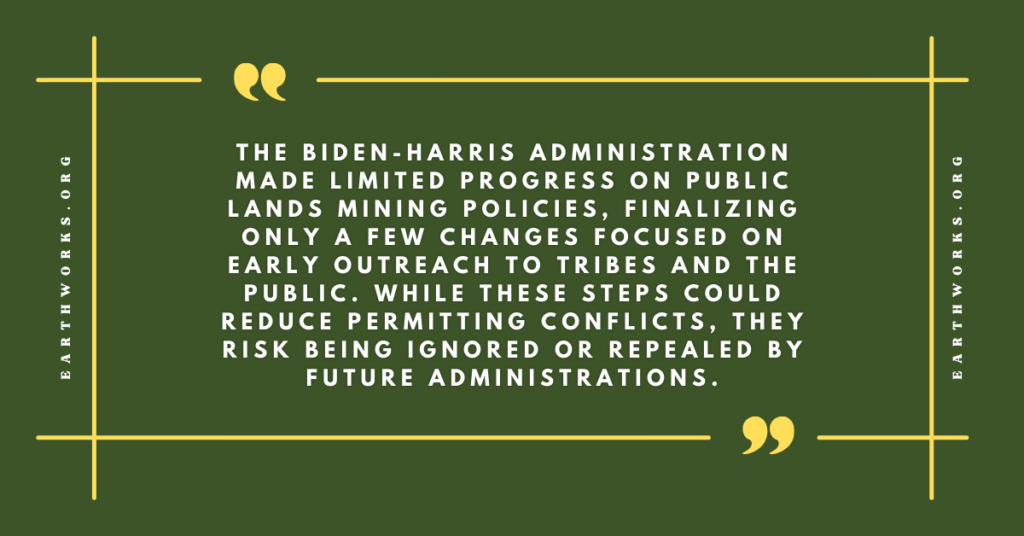|
Getting your Trinity Audio player ready...
|
The Biden-Harris Administration ends without significant changes to our public lands mining policies. Despite proposing comprehensive changes to statute, regulation, and policy, the Administration finalized only a few. They were primarily about early outreach to Tribes and the public before mining occurred. To be sure, the Trump Administration may ignore or repeal these new instructions. However, honoring these steps forward can help avoid conflicts around permitting new mines.
For a quick refresher of the President’s term on mining reform:
- Feb 2021. Executive Order (EO) 14017 America’s Supply Chains directed all federal agencies to report within 100 days on how to improve ways to source metals, including from public land mines.
- June 2021. One hundred days later, as directed, the public lands agencies recommended updating their mining regulations. The report stated: “Congress should enact comprehensive reform of the GML (General Mining Law) of 1872 and USDA (Agriculture Department) and DOI (Interior Department) should strengthen the regulations governing mining on public lands.”
- Sept. 2021. Earthworks, along with a coalition of Tribes, Indigenous-led organizations, and conservation groups, petitioned the Department of Interior’s Bureau of Land Management for better mining rules.
- Sept 2021. Congress passed Section 40206 of the Bipartisan Infrastructure Law directing our public lands agencies to 1) calculate the time spent permitting hardrock mines, 2) develop mine permitting metrics, and 3) measure performance against those metrics to achieve better environmental outcomes.
- May 2022. In response to Congress and our petition, the Administration convened a meeting of stakeholders, including Earthworks, to announce an Interagency Working Group to deliver mining reform recommendations.

- Nov. 2022. At the annual Tribal Nations Summit, the Interior and Agriculture Secretaries announced mining reforms specifically to empower Tribal communities and improve consultation processes. The Administration chose these reforms to build upon their Uniform Standards for Tribal Consultation.
- Sept 2023. The Interagency Working Group delivered its final report. It contained more than 60 recommendations for updates to the 1872 Mining Law, regulation, policy, and permitting. Notably, the Government determined that the average and median times to permit public land mines is only three years. Further, they found the primary cause of permit delays stems from mining companies providing incomplete, inaccurate, and/or untimely information to under-resourced agencies. The Government also specifically refuted often-cited mining industry estimates that mine permit times span 7-10 years or longer- labeling the data “unsubstantiated.” These conclusions help bolster the advocacy from mining-impacted communities, raising fierce opposition against “sham permitting reform,” weakening the 1872 Mining law and limiting environmental reviews.
- Sept. 2024. Building upon the Tribal Nations Summit and IWG report, the BLM finalized the Instruction Memorandum, IM 2024-048. It directs field offices to notify neighboring Tribes when the BLM receives a notice for mine exploration. Before, mining companies could begin constructing roads, drilling, blasting, and conducting other exploration activities without any notice to Tribes. This memorandum invites Tribes to meet with BLM before exploration begins to confidentiality and share information that may help BLM preserve sacred sites or prevent mining in some areas. It also allows Tribes to withhold certain sensitive information.
- Nov. 2024. The BLM finalized their Information Bulletin, IB 2025-0013, notifying field offices of the Infrastructure Law’s permitting metrics for public participation and interagency coordination. These metrics include conducting Tribal outreach before exploration begins (IM 2024-048) and receiving input from other communities before the environmental reviews begin.
The government should put into practice its ongoing commitment—before and during environmental reviews and Tribal consultations—to listen, respect, and incorporate traditional knowledge and community input in mine plans if only to avoid or mitigate potential mine permitting conflicts early on. Now is the time to build power and organize for future Administrations, when more lasting reforms—including dozens more from the Interagency Working Group—can become law.
